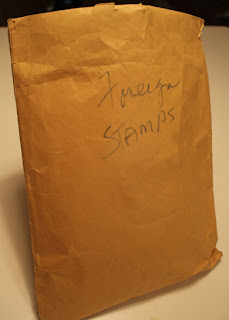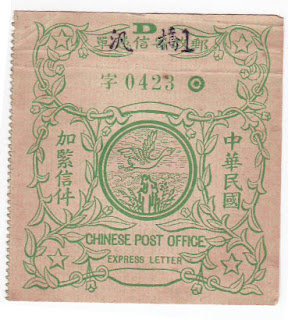We’ve all heard of or have seen the rare stamps that fetch thousands or millions at auction. So, when we come across a few that look old, peculiar, or unique we immediately think, “Is this one worth something?” As I peered into an envelope holding a large collection of domestic and international stamps at an estate sale I thought the same thing. By their look I knew they were old, but I would prefer to find out in the privacy of my den. I was excited and a little taken aback when the price came back as ten dollars, which included other things I was buying. “Did they just make a mistake?” “Did they even look?” I asked my daughter who accompanied me on this dig.
I hadn’t really looked at the stamps before I’d bought them; the mystery is half the fun. However, I had inspected a piece of folded newspaper in the envelope and found written on the outside in dip-pen “Irish.”
The newspaper itself had had a partial date of 1930 and one of the stamps had a cancellation date of 1915. I was hooked.
My parents once tried to start me stamp collecting, but my short 11-year-old attention span couldn’t sustain the interest in the maintenance of an album and a sandwich bag of starter stamps. I find that many years later not much has changed, the quantity, age, and uniqueness was staggering my brain. I was amazed at what one manila envelope could hold. The envelope, when I spilled it out on the table contained over 500 stamps from all over the world and most were pre-1925. However, before I started counting my money I needed a reality check
In researching stamps and their value I found website after website with tips designed to burst the bubble of anyone who was holding a collection of stamps. All of the sites gave advice to the effect – “Don’t Get excited…” “…probably worth nothing.” “…usually not even worth face value.” The overall impression was that while you may have some that could be worth a small fortune, there are still a multitude of steps you need to go through to verify their value.
First, There’s the age. Basically, any stamp from 1930 on is not likely to hold anything more than face value. This is because it was around the 1930’s that stamp collecting become popular and the US government and possibly other governments began printing stamps in higher quantities to feed this passion. If they are older, there is yet another list of variables on which value is based: gum/no gum, franked/un-franked (canceled), centered/un-centered, thin, faded, hinged/unhinged. After reading through all of these I was becoming unhinged!
Then there’s the Scott manual, the bible of stamp values, which is a useful tool for understanding the categories and variables that give stamps their value. But even with the knowledge in Scott you still have very little chance of walking away with a tidy sum. The slightest difference from your stamp to the one in the catalog, and I mean microscopic difference, can render your stamp worthless. Additionally, you may need a certificate of quality drawn up by a qualified expert sanctioned by one of the Philatelic institutions so you can verify your stamps are the real (valuable) deal.
Exhausted? After all my digging, researching and hoping I just became tired and resolved to the fact that I probably hadn’t found the lost treasure of the Sierra Madre. Heck! I hadn’t even found the stamp commemorating it.
But, what I did find was an appreciation for the hobby of collecting stamps. For all the reasons I dig through the past, stamps contain a lot of the same qualities. They are tiny time capsules, in effect “time” stamps of a period in a country’s history. They note changes in country name, leadership, and currency. The process by which they are created, printed, cancelled, and collected is interesting. While I probably should go out and buy an album to sort these, it will be hard to separate them from the unique little folded papers and other odd methods (see below) used by the original owner to do the same. I am still going through these and trying to learn about what I’ve found.
In the end I got what I paid for. It won’t secure my daughter’s future Ivy League college bills, but then again, by the time she’s ready for college, they just might. I bought someone's appreciation for collecting and in return it has spawned and renewed my interest as well.














No comments:
Post a Comment
Found something unique? See something here you want to know more about? Start the discussion - I'll respond. Really!